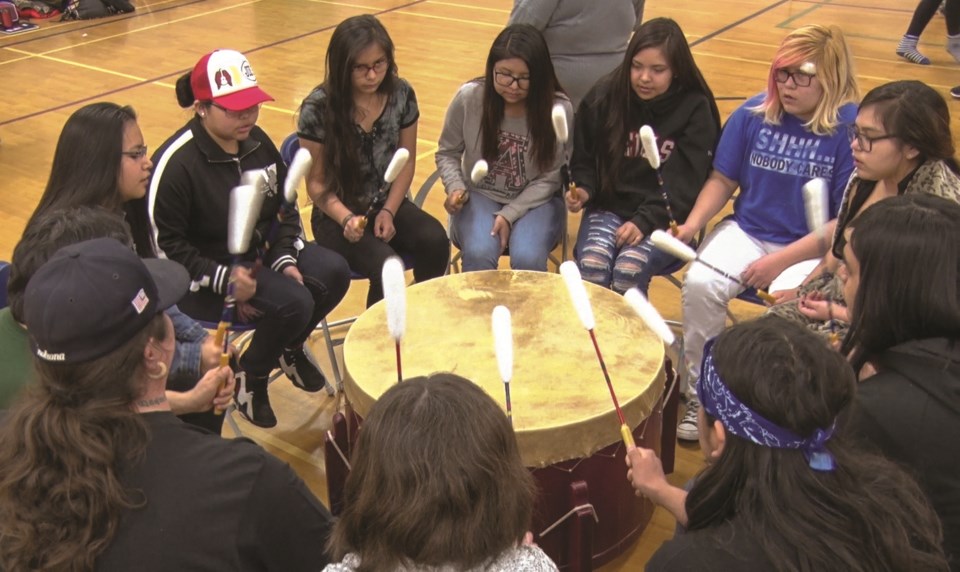Grade 11 Pemberton Secondary Student (PSS) Chenielle Qamu’ea7 Wallace had never seen a 24 Hour Drum, School District 48’s annual, student-led celebration of Indigenous culture and language, before last week.
It’s an event that, until the pandemic, would pack school gymnasiums with students, educators and Indigenous leaders from across the Sea to Sky eager to share the traditional songs, dances, and, of course, drumming of the Lil’wat and Squamish Nations. This year, however, it was forced to move online for the first time, and for all the obvious challenges the digital format presented—there was, like everything on Zoom these days, the occasional technical difficulty to work through—the power of the collective message shared reverberated through the screen, like the booming thud of a drum. “Even though we weren’t able to be in one room, you could still feel that power,” said Wallace, who is Lil’wat. “I think that’s what made the 24 Hour Drum this year so amazing and heartfelt and breathtaking. Even though we weren’t in the same room, we could still create the same energy and feel the same empowering feeling.”
Going online came with other added benefits, too: Along with students from every public school in the district, the event was beamed into classrooms across the province, making it the farthest reaching 24 Hour Drum yet. “That is one of the gains of doing it on Zoom,” said Karen LaRochelle, district principal of Indigenous education. “People from outside the district can always access the link on the website in the future, but this was interactive with each other, and we would love to grow that.”
The more than 110 streamers heard traditional songs like the Lil’wat’s “Groundhog Song” and “Women’s Warrior Song,” the Squamish Nation’s “Water Song” and drumming from Don Ross Middle School students. But the event also served as an important forum for difficult discussions on matters of systemic racism, white fragility and the ongoing impacts of colonialism, culminating in the screening of a 30-minute documentary that featured interviews with students from across the district. The conversations were at turns raw and uncomfortable, honest and heartfelt, reflecting a year that has seen reports of racial violence and discrimination surge across B.C.
“There is some appreciation [of Lil’wat culture] but there are also some people that don’t understand and think of us as a big joke in the hallways, in the classrooms and even some of the teachers,” said a PSS student in the film. “We are people and we have feelings and we just want a little more respect of our culture just like everyone else.”
Wallace and her fellow Indigenous Student Leadership Team members developed the concept for the film, directed by Ed Carswell, and she was inspired to see so many of her peers charging headlong into discussions that can be difficult for anyone, let alone a 17-year-old. “It was very empowering for me to see all these other high-school students who are just as passionate as I am about this,” she said. “It’s very important to shine a light on this issue, because people have swept it under the rug because it makes them uncomfortable. I think it should make you uncomfortable because it’s not right at all.”
The Sea to Sky School District has gone to great lengths in recent years to incorporate elements of local First Nations culture and language into school life. But, as always, there are opportunities to improve, believes Wallace, who would like to see Indigenous history offered not just as an elective for upper-year students, but as a regular course offering that begins in Grade 8. “I feel like there’s so much that we’ve missed over the years,” she said. “In Grade 8 and 9, I felt very underwhelmed and kind of disappointed there wasn’t a class where I could learn every day about Indigenous culture and language.”
LaRochelle agreed there is a need to incorporate more Indigenous learning into the curriculum, and said the district is working with the Lil’wat Nation on an agreement to increase the visibility of Lil’wat language and culture and move away from a “Eurocentric way of scheduling” to a more inquiry-, project-based model.
“We have a lot of good work that has been done, but there’s so much more to go,” she said.







